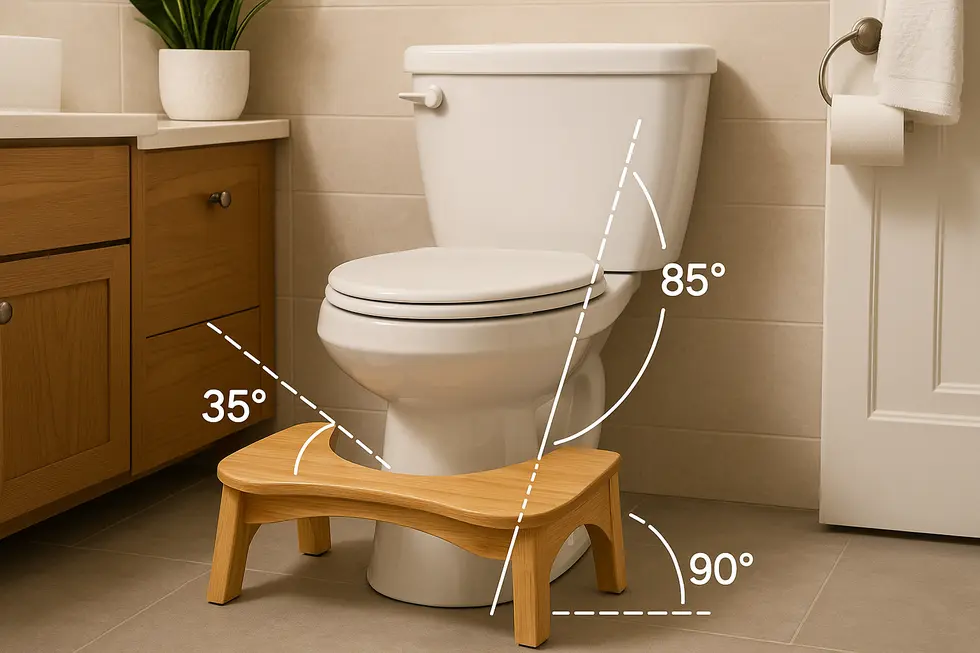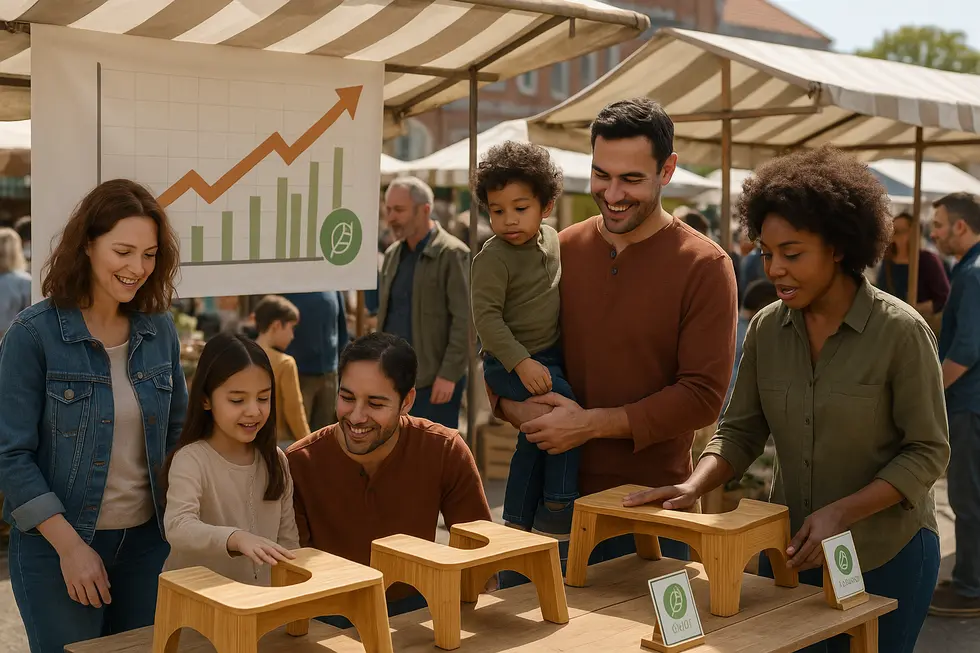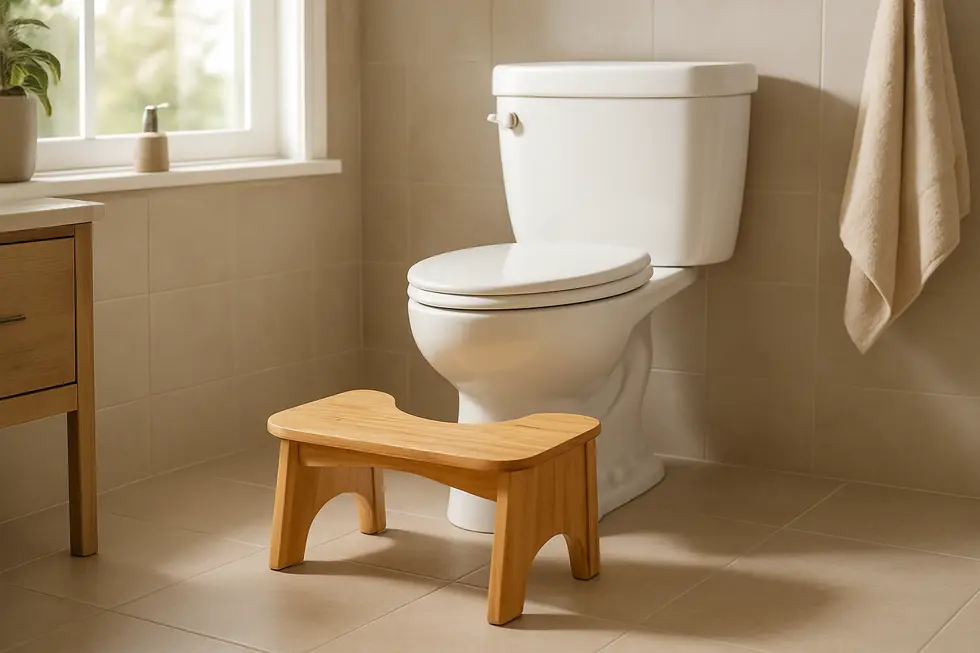Toilet Stools
Elevate Your Bathroom Experience: The Bamboo Toilet Stool Revolution
Incorporating a bamboo toilet stool into your bathroom setup can be a game-changer, offering ergonomic benefits rooted in science, sustainably sourced materials, and growing market enthusiasm. This article explores the convergence of health science, sustainable production, and evolving market dynamics that make bamboo toilet stools a preferred choice for families seeking comfort and ecological mindfulness.
From Sitting to Squatting Lightly: The Ergonomic Science Behind Bamboo Toilet Stools

Western toilets freeze the pelvis in a right angle nature never intended. When you slide your feet onto a 7-inch bamboo platform, the knees rise, the torso tilts, and the anorectal canal unfurls. Motion-capture trials show the angle between rectum and anal canal opens from roughly 92° to 118°, mirroring the 35–45° hip flexion of a full squat. This single geometric shift drives most of the health gains.
Electromyography confirms the story. With feet on the stool, puborectalis relaxation increases about 20 %, while intra-abdominal pressure falls. In a 52-participant crossover study the mean straining score dropped from 4.1 to 2.2 and average time on the toilet shortened by forty seconds. Less mechanical stress means fewer hemorrhoids, anal fissures, and pelvic floor issues over time, something gastroenterologists now mention alongside fibre advice.
Ergonomic details matter. An optimal height of 6–9 inches lifts the knees above the hips without pinching circulation. Bamboo’s high modulus-to-weight ratio lets makers pass ANSI load tests with a slender 18 mm laminated deck, leaving room for contoured arches that nest around most toilet bases. Non-slip silicone pads rated μ ≥ 0.65 prevent drift on glossy tiles, an important safeguard for seniors who adopt the stool for constipation relief. Collapsible versions—see a typical collapsible bamboo model—solve space constraints without sacrificing strength.
Material choice also affects indoor air and climate impact. Kiln-dried Moso bamboo bonded with E0 urea-free resin emits less than 0.01 ppm formaldehyde, well under California’s Prop 65 trigger. Its cradle-to-gate footprint is about 0.23 kg CO₂e, 40 % lower than comparable plastic. Add end-of-life compostability and the stool aligns with the growing preference for circular bathroom products, often purchased alongside bidet attachments for a fully low-impact routine. Our own detailed posture benefits guide explains how combining both tools deepens the ergonomic effect.
Clinicians even see benefits for pregnant users, whose expanding uterus can impede colon motility; elevating the feet relieves pressure without medication. For children overcoming toilet-training hesitation, the stable platform provides ground contact, promoting confidence and proper pelvic alignment. Ultimately the bamboo toilet stool is less a gadget than an anatomical correction: a renewable way to turn a daily necessity into preventive healthcare.
From Culm to Comfort: How Sustainable Craftsmanship Shapes the Modern Bamboo Toilet Stool

Few household items capture the full life-cycle of sustainability as elegantly as a bamboo toilet stool. The process begins in managed Moso plantations where culms reach harvest maturity in only four to five years, locking away roughly 35 t CO₂ per hectare each season. Select stems are felled without disturbing the root system, allowing new shoots to sprout naturally and keeping soil carbon intact.
Back at the mill, the canes are kiln-dried below 10 % moisture to inhibit mold and minimize dimensional change. Strips are then laminated using E0-grade urea-formaldehyde–free resins or MDI adhesives; both meet REACH and California Prop 65 thresholds for formaldehyde (<0.01 ppm), ensuring indoor air remains free of irritating VOCs. Computer-controlled routers sculpt the laminated blanks into a single flowing arc that cradles feet while maintaining a ±1.5 mm flatness tolerance. Although each unit weighs barely 1.6 kg, static tests confirm it can support a 90 kg load for 24 hours with less than 0.8 mm deflection—performance that rivals many hardwoods yet uses a fraction of the biomass.
Finishing is where green craftsmanship truly shines. Instead of solvent lacquers, makers apply water-borne polyurethane with VOC levels under 50 g L⁻¹, or choose plant-based hard-wax oils that accentuate bamboo’s natural nodes. Both options provide a moisture barrier essential for bathroom humidity while keeping cradle-to-gate emissions near 0.23 kg CO₂e—about 40 % lower than equivalent ABS plastic stools. Off-cuts never reach the landfill: short strips are converted into briquettes for kiln heat, closing the loop on factory energy.
The market rewards these choices. Despite raw material costs of just USD 1.45 per board-foot, perceived eco-premiums push retail margins above 40 %. Some workshops invite consumers to personalize height or add fold-flat hinges using SUS304 pins that withstand 240-hour salt-spray tests—ideal for coastal climates. Enthusiasts inspired to build their own can follow this DIY toilet stool tutorial to replicate professional ergonomics at home.
Manufacturers like Bamboomake publicize every stage, from plantation mapping to zero-waste polishing booths, illustrating how transparent supply chains turn a humble grass into a durable wellness tool.
From Niche Gadget to Bathroom Essential: How Bamboo Toilet Stools Are Reshaping the Sustainable Home Market

Global demand for bamboo toilet stools no longer sits on the fringe of wellness culture—it is firmly embedded in a fast-growing, eco-oriented household goods market. Industry analysts valued the category at roughly USD 153 million in 2023 and project a 7.8 % compound annual growth through the decade. Retail evidence supports the forecast: major supermarket chains in Europe and North America have tripled shelf space for bamboo bathroom accessories since 2022, signalling that sustainability has moved from boutique web shops to mainstream aisles.
What accelerates adoption is the happy convergence of personal health and planetary health. Social-media testimonials from physicians, physiotherapists, and lifestyle influencers explain in simple language how elevating the feet can shorten bowel-movement time by forty seconds and halve self-reported straining—data echoed by peer-reviewed crossover studies. At the same time, shoppers keen to trim plastic from their routines discover that laminated Moso bamboo offers a tactile, minimalist aesthetic without petrochemical guilt. Online search volumes for “toilet stool benefits” have risen sixfold in three years, and a recent reader survey on our in-depth guide to whether are toilet stools worth it showed 81 % of respondents planning a purchase within six months.
The socio-environmental ledger is equally compelling. Bamboo’s three-to-five-year harvest cycle outpaces hardwood growth by an order of magnitude, while managed plantations sequester about 35 tonnes of CO₂ per hectare annually. Life-cycle assessments calculate a cradle-to-gate footprint of just 0.23 kg CO₂e per unit—about half that of equivalent plastic devices—and end-of-life compostability sidesteps municipal landfill streams altogether. Certification regimes such as FSC and low-VOC finishing standards strengthen consumer trust, illustrating how circular-economy principles can be embedded in everyday objects without compromising performance.
Still, vigilance is required. Concentrated supply chains in southeastern China remain exposed to tariff volatility, and independent field audits are necessary to verify pesticide-free cultivation claims. Yet the momentum appears irreversible. As one sustainability journal reported on the 2025 rollout of bamboo hygiene products into 250 additional big-box stores, “what was once a curiosity has become the default green option.” (Source: BusinessGreen)
Final thoughts
The bamboo toilet stool stands out as a noteworthy choice for families wanting to enhance bathroom ergonomics with sustainable style. By marrying health benefits, eco-friendly materials, and market momentum, this simple yet effective addition to your bathroom promotes a healthier lifestyle, making it an ideal choice for environmentally conscious consumers.
Experience a new standard of clean with PEGABidet—designed for comfort, safety, and independence. Join thousands who trust us to make personal care simple and dignified. Contact us contact@pegabidet.com
About us
PEGABidet is a brand owned by L.A NEXTGEN LLC, based in California. We design intuitive, hygienic, and accessible bathroom solutions that prioritize safety, dignity, and independence. Our mission is to make personal care effortless and empowering for people at every stage of life.

